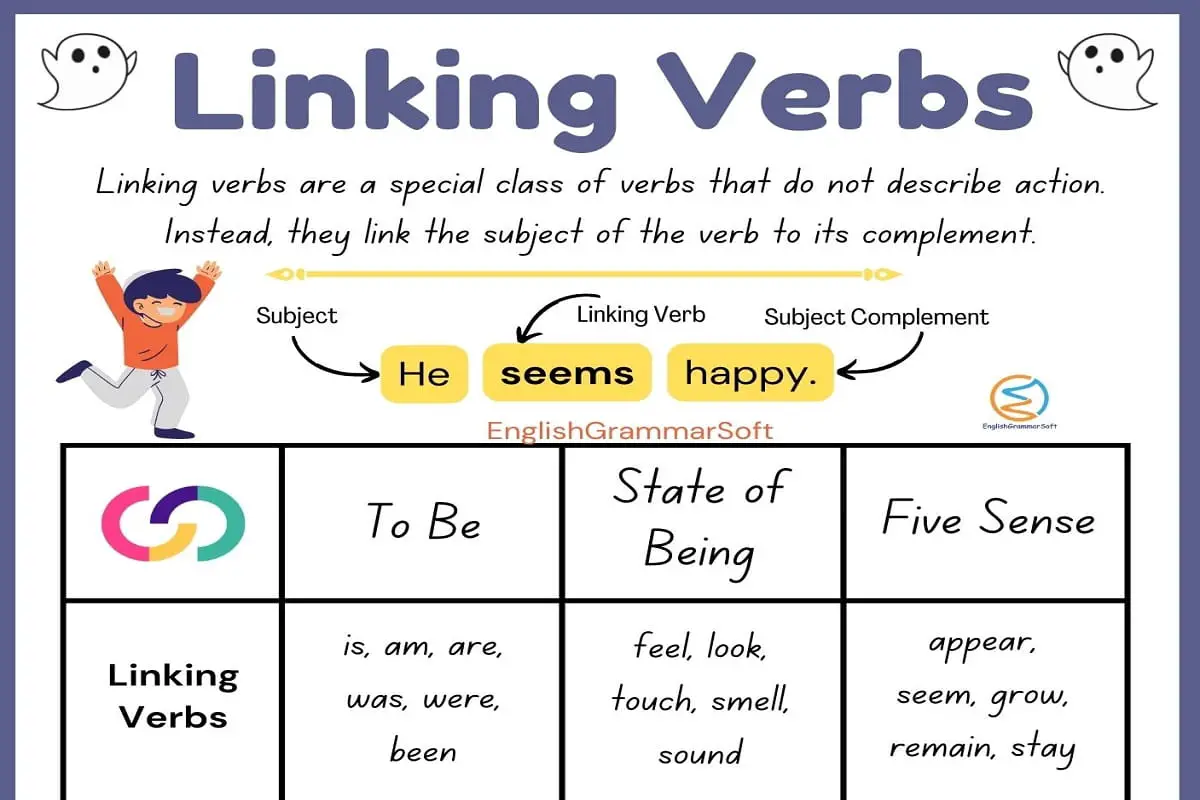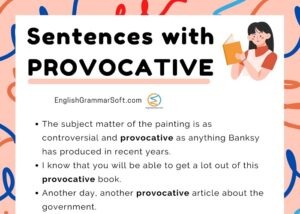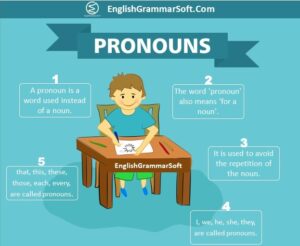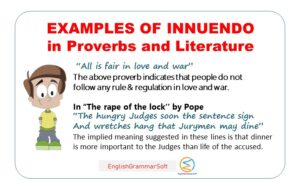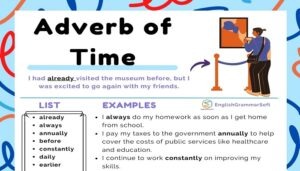Linking Verbs (Chart, Examples & List)
In linguistics, a verb is an element of a sentence that indicates the doer (agent) or receiver of the action. Linking verbs, also known as copular verbs or copulas, are verbs that serve to join the subject with its complement in a sentence.
A linking verb, also called a copula (from the Latin for ‘link’), is a verb that links the subject of a clause or sentence to a word or phrase (which may include a noun, adjective, adverb or pronoun) that describes or renames the subject.
What are linking verbs?
Linking verbs are a special class of verbs that do not describe action. Instead, they link the subject of the verb to its complement. The most common linking verb is the verb “to be.” Other linkage verbs include “become,” “seem,” “look,” “smell,” “taste” and “feel.” When these verbs are used to connect a subject to its complement, they are called linking verbs.
The different types of linking verbs
Linking verbs are of three types:
To Be Linking Verbs
These linking Verbs include is, am, are, was, were.
For example, He is a gentleman.
The State of Being Linking Verbs
These include seem, appear, become etc.
For example, The flowers appear to be wilting.
Five Senses Linking Verbs
These include senses of touch, sound, feel, smell and look. See these examples.
- The pie smells delicious. (smell)
- Gina felt terrible after she caught the flu. (feel)
How to identify linking verbs in a sentence
Linking verbs are often followed by adjectives or nouns that describe or identify the subject. In the following examples, the linking verbs are in boldface type, and the adjectives and nouns that describe or identify the subjects are in italics:
- The pie smells delicious. (The verb smells links the subject pie to the adjective delicious.)
- I am feeling better today. (The verb am links the subject I to the adjective better.)
- The room looks small from here. (The verb looks links the subject room to the adjective small.)
A linking verb “to be” expresses existence or identity. For example, in the sentence “John is a teacher,” “is” expresses existence (identity) and links the subject, “John,” with the word that describes him, “teacher.”
You ca easily identify linking verbs in these examples.
- He became angry. (The subject, He, is linked to the adjective angry.)
- I am ready. (The subject, I, is linked to the adjective ready.)
- They seem happy. (The subject, They, is linked to the adjective happy.)
- We look tired. (The subject, We, is linked to the adjective tired.)
Some linking verbs that can also be used as action verbs
In addition to the most common linking verbs, many action verbs can also be used as linking verbs. For example, “He seems happy” and “He smells the coffee.” The linking verb in these sentences is bold.
These are some common verbs that can be used as linking verbs or action verbs, depending on how they are used in a sentence:
- appear
- become
- remain
The verb remain can be used as an action verb (“He remained there for hours”) or a linking verb (“That remains to be seen”).
The difference between linking verbs and action verbs
Linking verbs are verbs that do not express action but instead link the subject of a verb to a word that describes or identifies the subject. In other words, a linking verb is used to equalize the subject with the noun or adjective that follows it. The most common linking verb is the form of the verb “to be.” Other linking verbs include: appear, become, feel, growth, look, remain, smell, sound, taste, and turn.
Action verbs express specific physical or mental actions and are not equalizing like linking verbs. You can usually tell when a verb is an action verb because you can put an adverb before or after it and the meaning of the sentence will not change. For example, in the sentence “He swims quickly,” you can change “swims” to “is swimming” and the meaning of quickly will still make sense. You cannot do this with a linking verb. For example, in the sentence “He is happy,” you cannot say “He is happily.”
Linking Verbs List
| To Be Linking Verbs | 5 Senses Linking Verbs | State of Being Linking Verbs |
|---|---|---|
| is am are was were been | Look Feel Taste Smell Sound | Appear become Grow Remain Stay Seem Turn |
Linking Verbs Examples
Linking verbs are one type of verb that can be used to connect a subject to a word or phrase that describes or identifies the subject. In other words, the linking verb helps to describe the state or condition of the subject.
- She looks gorgeous.
- I felt tired after the long journey.
- She appears happy but she is sad deep down.
- The Air Jordan shoes were very popular with young people.
- Lavender is a fragrant herb widely used for culinary purposes.
- The design of the new building was controversial among residents.
- She felt better.
- After the storm, the sky looked like a beautiful painting.
- He is excellent at soccer and baseball.
- Your shoes look good with your new shirt.
- Mr. Wilson has been working here since 2019.
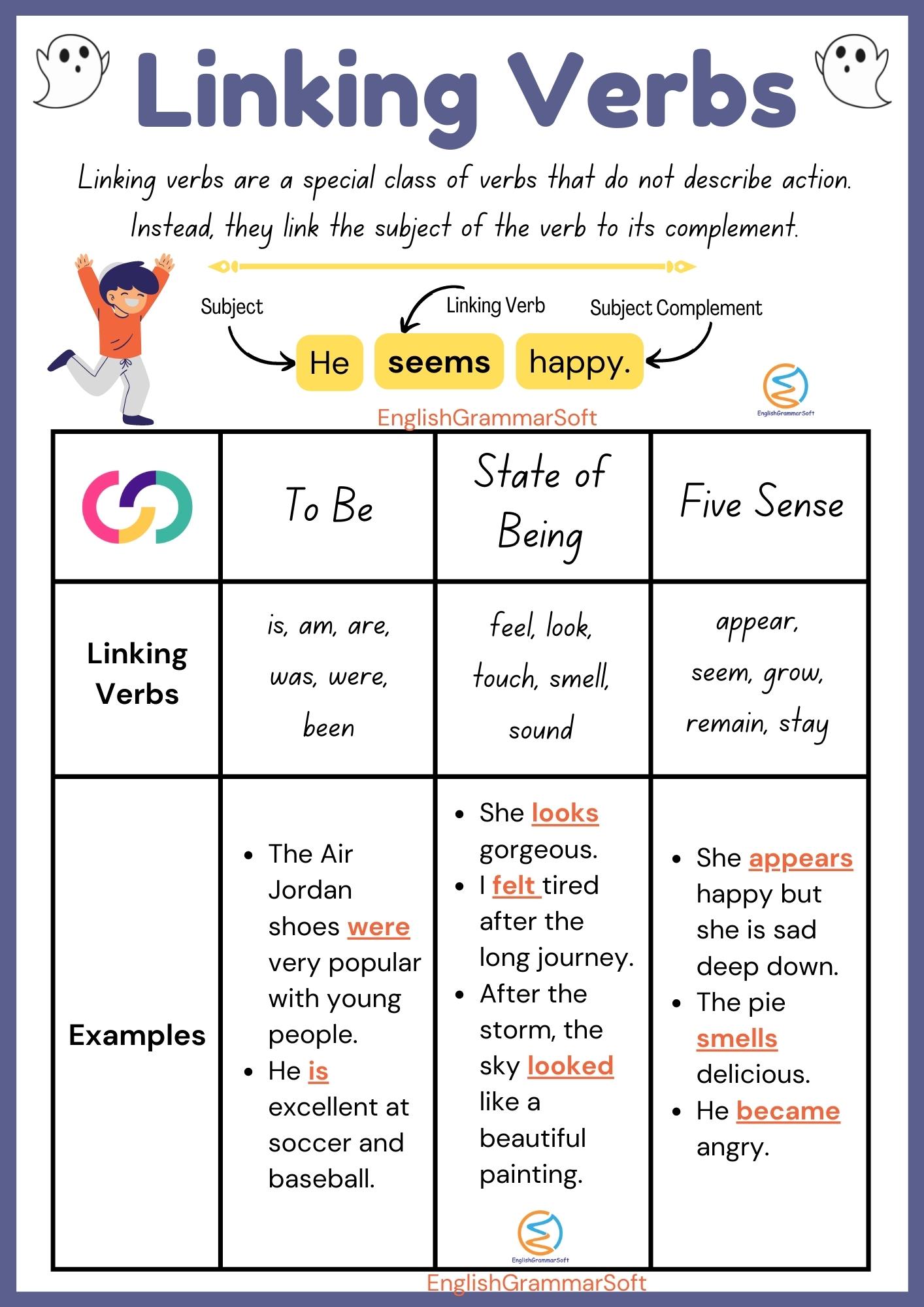
More to read
